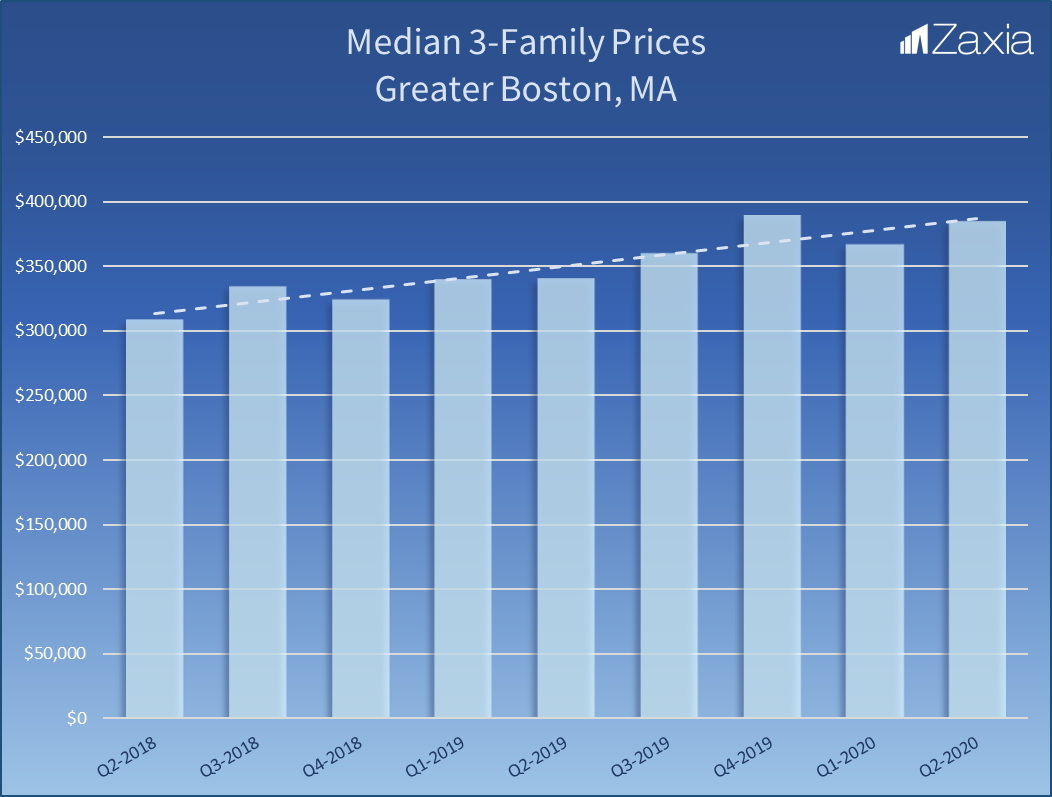Calamities
Analysts have every reason to expect that the coronavirus will result in a drop
in prices for apartment buildings. Out-of-work tenants are less likely to be
able to make rent payments. Rent moratoriums prevent landlords from taking
action against non-paying tenants. Rent losses increase. Buildings' net
incomes decline. Value depends on income, so prices decline.
But the data don't always tell the story we expect. Zaxia, a commercial real
estate Web site, publishes a median price trend chart for the most common small
apartment type in Greater Boston, the three-family. Zaxia's second quarter data
include property transfers that took place in the months of April, May, and
June of this year. The second quarter median price shows no decline from the
first quarter. It shows a continuation of the steady trend to price increases
in the three-family market dating back two years.
Zaxia also publishes a median price trend chart for each of nine of Boston's
satellite cities plus Dorchester, quarter by quarter, for the last two years.
Zaxia aggregates the data from these ten communities to produce the Greater
Boston trend chart.

Three-families are a good barometer for the larger small apartment market and,
to an extent, for larger apartments. Single-family houses are owner-occupant
properties, and their price trend says little about investment properties. The
same is true of two-families, which in most cases are owner-occupied.
Three-families, on the other hand, are largely rental income properties. They
are a favorite of small investors. What is true of rents and prices for
three-families is generally true for four-families and up. Most three-families
date from 1900 to 1920. They include the familiar "three-decker." The volume
of sales of three-families, running to 250 in a typical quarter, makes their
price trends statistically significant.
Generally, Boston's satellite cities have seen upward price trends in 2018-2020.
Brockton showed 20% appreciation in the last year, Lowell 25%, and Fall River 30%.
Fitchburg, on the other hand, has shown a 20% decline. Other cities are intermediate
and typically show an upward trend. Dorchester, with the highest prices of any
of the communities, has seen level prices in recent years.
Prices have risen, but the volume of sales has declined sharply. See Zaxia's
chart of quarterly sales volume over the past two years. A decline in volume,
if sustained, means that buyers no longer agree with sellers' expectations for
price and may foretell a later market decline. Or, it may be that both buyers
and sellers have gone to the sidelines, to see where prices shake out.
Overall appreciation for three-families in Greater Boston has been 25% in two years.
About Us
Eric Reenstierna Associates LLC is a real estate appraisal firm taking on valuation and consultation assignments in Greater Boston, Massachusetts and New England. Eric Reenstierna, MAI, is the office's principal and is a commercial real estate appraiser.
Explore
Contact
24 Thorndike Street
Cambridge, Massachusetts 02141
(617) 577-0096
ericreen@tiac.net
